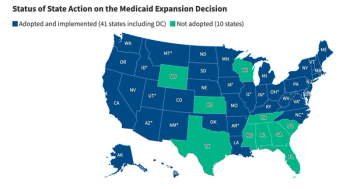
Diabetes associations develop consensus algorithm for the management of hyperglycemia in type 2 diabetes
The American Diabetes Association (ADA) and the European Association for the Study of Diabetes (EASD) have developed a consensus algorithm for the management of hyperglycemia in type 2 diabetes. The statement, published in the August issue of Diabetes Care, was created for several reasons.
The American Diabetes Association (ADA) and the European Association for the Study of Diabetes (EASD) have developed a consensus algorithm for the management of hyperglycemia in type 2 diabetes. The statement, published in the August issue of Diabetes Care, was created for several reasons.
This consensus algorithm is intended to help patients reach recommended glycemic goals; the most recent goal recommended by the ADA is "in general" a hemoglobin A1c (HbA1c) level of <7% or as near <6% as possible without significant hypoglycemia. The consensus opinion, the authors stated, is that an HbA1c level of ≥7% should prompt action to begin or to modify therapy in an attempt to achieve an HbA1c level as close to the nondiabetic range as possible.
Nonetheless, the authors took into account that in most patients with type 2 diabetes, lifestyle recommendations do not result in reaching or maintaining metabolic goals because patients fail to lose weight, regain weight, have progressive disease, or experience a combination of these factors. Therefore, the authors stated that metformin therapy also should be initiated at diagnosis and should be titrated to its maximally effective dose, as tolerated, over a 1- to 2-month period.
If these first steps fail, physicians should add a second medication 2 to 3 months after the initiation of therapy or whenever the HbA1c goal is not reached. However, the only strong consensus regarding this second medication is that physicians should choose insulin, a sulfonylurea, or a thiazolidinedione. In making this decision, physicians must weigh the relative increased costs of the newer agents against the agents' relative benefits.
If these strategies do not result in goal glycemia levels, physicians have other options. When HbA1c is close to the goal (<8.0%), a third oral agent could be added; however, this approach is more costly and potentially less effective in lowering glycemia levels relative to another option: initiating or intensifying insulin therapy. To intensify insulin therapy, injections of short- or rapid-acting insulin before certain meals may be added to the regimen.
The authors stated that their recommended guidelines-achievement and maintenance of nondiabetic glycemic levels through lifestyle changes and metformin treatment, rapid initiation of other medications when glycemic goals are not being reached, and early addition of insulin therapy-may help to substantially reduce the morbidity associated with long-term complications of type 2 diabetes.
SOURCE Nathan DM, Buse JB, Davidson MB, et al. Management of hyperglycemia in type 2 diabetes: a consensus algorithm for the initiation and adjustment of therapy: a consensus statement from the American Diabetes Association and the European Association for the study of diabetes. Diabetes Care. 2006;29:1963–1972.
Newsletter
Get the latest industry news, event updates, and more from Managed healthcare Executive.





















































